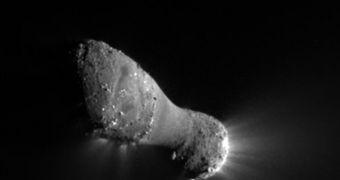The NASA Deep Impact spacecraft passed by a small comet called Hartley 2 late last year, revealing the celestial body to be extremely active. Now, a study details those findings further, suggesting that the comet is in fact hyperactive, and interesting to study.
Hartley 2 was studied as part of EPOXI, the extended mission that the Deep Impact probe engaged in before finally being shut down. The flyby took place on November 4, 2010, and details of the study appear in this week's issue of the top journal Science.
The comet was visited after the spacecraft had already traveled more than 3.2 billion miles (5.1 billion kilometers) through the solar systems, analyzing other comets in the process. Deep Impact launched on January 12, 2005, aboard a Delta II delivery system.
It flew by comet Tempel 1 in 2005, and was then put into hibernation mode until further use could be extracted from it. When mission controllers got a chance to view Hartley 2, they leaped at the opportunity, and reactivated the spacecraft.
“From all the imaging we took during approach, we knew the comet was a little skittish even before flyby,” explains NASA Jet Propulsion Laboratory (JPL) EPOXI project manager Tim Larson.
“It was moving around the sky like a knuckleball and gave my navigators fits, and these new results show this little comet is downright hyperactive,” he adds from the JPL, in Pasadena, California.
During the flyby, the Deep Impact probe revealed important activities to be taken place on the comet's surface, including massive releases of water, and the emission of carbon dioxide (CO)-powered jets.
However, these chemicals were not being released in consistent patterns across the surface of Hartley 2. The ends of the comet appeared to be the most active regions. At its point of closest approach, the spacecraft was 431 miles (694 kilometers) above the comet's surface.
“Hartley 2 is a hyperactive little comet, spewing out more water than most other comets its size. When warmed by the Sun, dry ice – frozen carbon dioxide – deep in the comet's body turns to gas jetting off the comet and dragging water ice with it,” said Mike A'Hearn.
The expert, who holds an appointment as a professor at the university of Maryland in College Park, is the principal investigator for the EPOXI mission. ”These could represent a separate class of hyperactive comets,” he adds.
“Or they could be a continuum in comet activity extending from Hartley 2-like comets all the way to the much less active, 'normal' comets that we are more used to seeing,” A'Hearn concludes.

 14 DAY TRIAL //
14 DAY TRIAL //